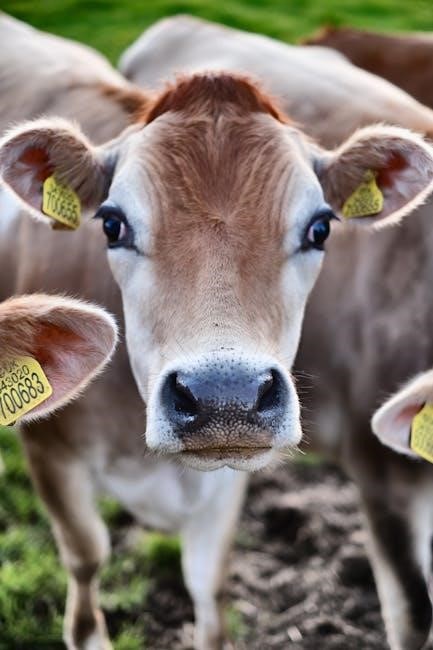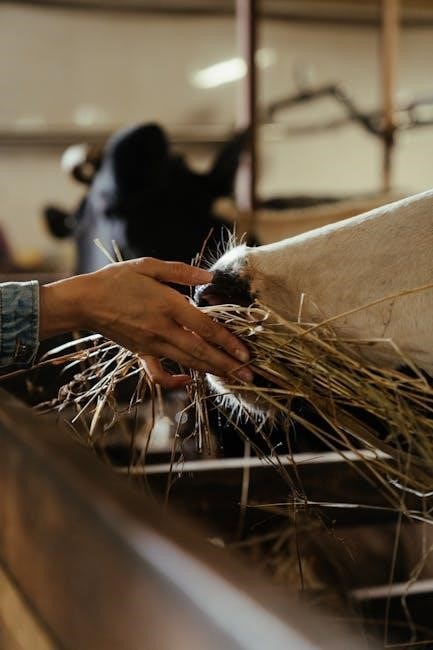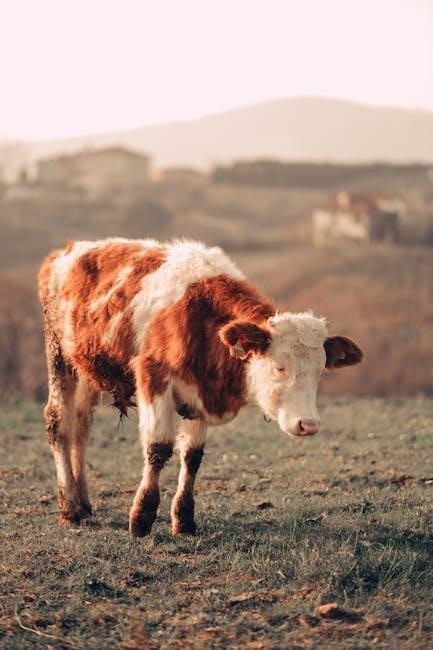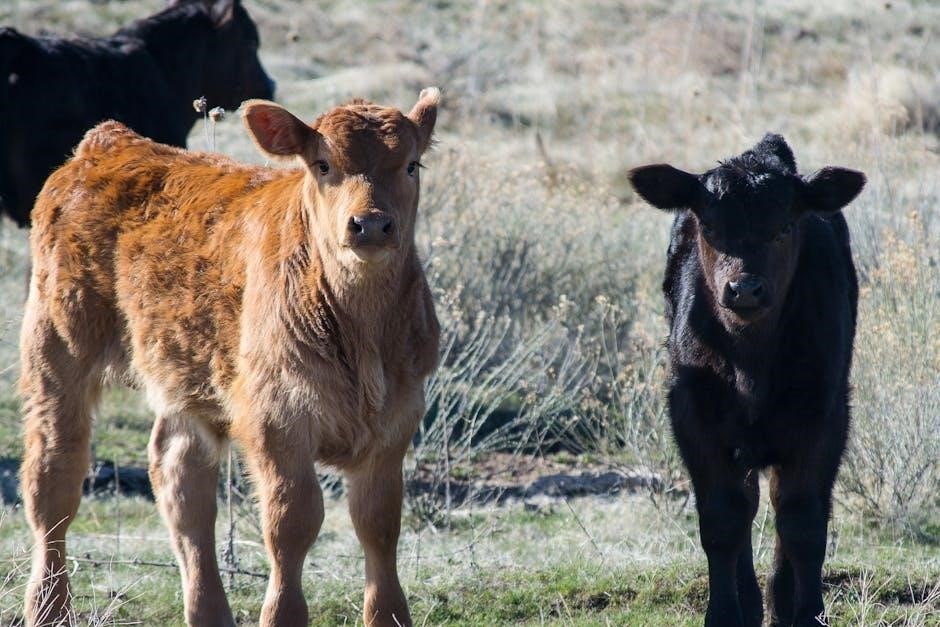Calf stretches are simple exercises targeting the gastrocnemius and soleus muscles in the lower leg. Regular stretching improves flexibility, reduces muscle tightness, and enhances athletic performance.
Why Calf Stretches Are Important
Calf stretches are crucial for maintaining lower leg flexibility and preventing tightness that can lead to pain or injury. Tight calf muscles often contribute to conditions like plantar fasciitis, Achilles tendinitis, and shin splints. Regular stretching improves circulation, reduces muscle soreness, and enhances athletic performance. It also promotes proper gait mechanics, reducing the risk of foot and ankle issues. Incorporating calf stretches into a daily routine is essential for overall mobility and long-term muscle health.
Benefits of Regular Calf Stretching
Regular calf stretching enhances flexibility, reducing muscle tightness and improving range of motion. It helps prevent injuries like shin splints and Achilles tendinitis while alleviating conditions such as plantar fasciitis. Calf stretches improve circulation, promote recovery after exercise, and enhance athletic performance. Consistent stretching also supports proper posture and gait, reducing the risk of foot and ankle pain. Incorporating calf stretches into a daily routine contributes to overall muscle health and maintains mobility for everyday activities and sports.

Understanding Calf Anatomy
The calf comprises the gastrocnemius and soleus muscles, which connect to the Achilles tendon, influencing ankle mobility and lower leg stability. Understanding their structure aids in effective stretching.
The Role of Gastrocnemius and Soleus Muscles
The gastrocnemius and soleus muscles play crucial roles in ankle movement. The gastrocnemius, a two-joint muscle, facilitates knee flexion and ankle plantarflexion, while the soleus focuses on plantarflexion. Together, they contribute to walking, running, and balance. Tightness in these muscles can lead to conditions like plantar fasciitis or Achilles tendinitis, making stretching essential for maintaining flexibility and preventing injuries. Regular stretching helps reduce muscle tension and enhances overall lower leg functionality.
Connection Between Calf Muscles and Achilles Tendon
The calf muscles, including the gastrocnemius and soleus, are connected to the Achilles tendon, which attaches to the heel bone. Tightness in these muscles can strain the tendon, leading to pain and conditions like Achilles tendinitis. Stretching the calf muscles helps reduce tension in the Achilles tendon, promoting better mobility and lowering the risk of injuries. Proper stretching techniques are essential to maintain healthy connectivity and prevent discomfort in the lower leg and heel region.
Types of Calf Stretches
Common calf stretches include standing, seated, and towel stretches, as well as stair stretches targeting the Achilles tendon. Each method offers unique benefits for flexibility and mobility.
Standing Calf Stretch
Stand facing a wall with hands at eye level. Extend one leg back, keeping the heel on the ground and knee straight. Slowly bend the front knee, leaning into the wall until a stretch is felt in the calf. Hold for 15-30 seconds and switch legs. This stretch targets the gastrocnemius and soleus muscles, improving flexibility and reducing tightness. It’s ideal for pre- or post-activity to enhance mobility and prevent stiffness.
Seated Calf Stretch
Sit on the floor with legs extended straight. Loop a towel or resistance band around the ball of one foot. Gently pull the towel toward you, keeping the knee slightly bent, until a stretch is felt in the calf. Hold for 15-30 seconds and repeat on the other side. This stretch effectively targets the soleus and gastrocnemius muscles, improving flexibility and reducing muscle tension without putting excessive strain on the Achilles tendon.
Using a Towel for Calf Stretches
Sit on the floor with legs extended straight. Loop a towel around the ball of one foot, holding both ends firmly. Gently pull the towel toward you, keeping the knee slightly bent, until a stretch is felt in the calf. Hold for 15-30 seconds, then switch sides. This method is ideal for those who prefer a controlled stretch without equipment, targeting the soleus and gastrocnemius muscles effectively. Avoid bouncing to prevent injury and focus on a steady, gentle pull for maximum benefit.
Stair Stretch for Achilles Tendon
Stand on a stair with your heels hanging off the edge. Hold the railing for support and slowly lower your heels until a stretch is felt in the Achilles tendon and calf. Hold for 15-30 seconds, then rise back up. Repeat 2-3 times. This stretch targets the Achilles tendon and plantar fascia, helping to reduce stiffness and improve mobility. Perform it with the knee straight for the gastrocnemius and bent for the soleus. Ideal for relief from tightness and injury prevention.

Best Practices for Calf Stretching
Hold stretches for 15-30 seconds, avoid bouncing, and focus on static stretches. Warm up before stretching to enhance flexibility and reduce injury risk.
Duration and Frequency of Stretches
Aim to hold each calf stretch for 15-30 seconds to maximize flexibility gains. Perform stretches 2-3 times per session, ideally 2-3 times daily. Consistency is key for long-term benefits. Start with shorter durations and gradually increase as comfort allows. Overstretching can lead to discomfort, so listen to your body and adjust accordingly. Regularity ensures sustained improvements in muscle elasticity and injury prevention; Make stretching a daily habit for optimal results.
Proper Technique to Avoid Injury
Proper technique is crucial to avoid injury during calf stretches. Always warm up before stretching to prevent muscle strains. Use controlled movements, avoiding bouncing, which can cause micro-tears. Keep stretches gentle and within a comfortable range. If pain occurs, stop immediately. Focus on maintaining proper posture and alignment to target the correct muscles. Breathing deeply can help relax the muscles, enhancing the stretch. Avoid forcing beyond a mild stretch to ensure safety and effectiveness. Technique consistency prevents injuries and promotes optimal benefits.
Static vs. Dynamic Stretching
Static stretching involves holding a stretch for 15-30 seconds, targeting muscle length and flexibility. It’s ideal after workouts to relieve tension. Dynamic stretching uses active movements, mimicking sport actions, improving range of motion and reducing injury risk before activities. Both methods are effective but serve different purposes. Static stretching enhances flexibility, while dynamic prepares muscles for movement. Combining both in a routine offers balanced benefits for athletes and individuals seeking optimal muscle function and injury prevention.
Calf Strengthening Exercises
Calf strengthening exercises, like eccentric calf raises and resistance band workouts, improve muscle endurance and prevent injuries, enhancing overall lower leg stability and performance.
Eccentric Calf Strengthening
Eccentric calf strengthening focuses on the lengthening phase of muscle contraction, improving strength and reducing injury risk. It involves raising the heels, holding, then slowly lowering. This method enhances muscle elasticity and balance, often used in rehabilitation for Achilles tendinitis and plantar fasciitis. Regular practice boosts lower leg stability and performance, making it a key exercise for athletes and individuals with calf-related issues.
Resistance Band Exercises
Resistance band exercises are effective for strengthening calf muscles. Loop the band around the ball of your foot while seated, then press your foot downward, stretching the band. This targets the gastrocnemius and soleus muscles, improving strength and flexibility. The controlled resistance helps build muscle endurance without heavy equipment. Regular use enhances lower leg stability and complements stretching routines for overall calf health and athletic performance.

When to Perform Calf Stretches
Calf stretches are most effective when done before physical activity to prevent injury and after exercise to aid recovery and reduce muscle soreness.
Before Physical Activity
Stretching your calves before physical activity is essential to prevent injuries and improve performance. Tight calf muscles can lead to poor movement patterns and increase the risk of strains or plantar fasciitis. Engage in gentle calf stretches, such as standing or seated stretches, to enhance blood flow and flexibility. Hold each stretch for 15-30 seconds and avoid bouncing to ensure effective preparation for exercise or sports. Proper warm-up techniques also reduce muscle stiffness, enabling better range of motion during activity.
After Exercise or Sports
Stretching your calves after exercise or sports is crucial for promoting recovery and reducing muscle soreness. Post-activity stretches help lengthen the muscles, improving flexibility and preventing tightness. Static calf stretches, such as standing or seated stretches, are ideal for cooling down. Hold each stretch for 15-30 seconds to allow the muscles to relax and recover. This routine also helps maintain range of motion and reduces the risk of injury. Incorporating calf stretches post-exercise supports overall muscle health and enhances athletic performance.

Calf Stretches for Specific Conditions
Calf stretches are beneficial for conditions like plantar fasciitis, Achilles tendinitis, and shin splints. Regular stretching can alleviate pain, improve mobility, and enhance recovery in these cases.
Plantar Fasciitis and Calf Stretching
Plantar fasciitis often relates to tight calf muscles, as the Achilles tendon connects to the heel. Gentle calf stretches, such as towel stretches or standing calf stretches, can reduce tension in the plantar fascia. Regular stretching helps alleviate heel pain and improves mobility. Hold stretches for 15-30 seconds to maximize effectiveness. Incorporating these exercises into a daily routine can significantly improve symptoms and support long-term recovery from plantar fasciitis.
Achilles Tendinitis Relief
Achilles tendinitis is often linked to tight calf muscles, as the Achilles tendon connects the calf to the heel. Gentle calf stretches, such as stair stretches or towel-assisted stretches, can reduce tension and alleviate pain. Holding stretches for 15-30 seconds promotes flexibility and relief. Avoid bouncing during stretches to prevent further irritation. Incorporating these exercises into a daily routine can help manage symptoms and support recovery from Achilles tendinitis effectively.
Shin Splints and Calf Stretching
Shin splints are often caused by tightness or inflammation in the lower leg muscles, particularly the calf. Gentle calf stretches can help alleviate shin splint discomfort by improving flexibility and reducing muscle tension. Standing calf stretches, seated stretches, and towel-assisted stretches are effective for targeting the gastrocnemius and soleus muscles. Regular stretching can also prevent shin splints by enhancing muscle elasticity and promoting proper blood flow to the affected areas, making it easier to engage in physical activities without pain.

Creating a Calf Stretch Routine
Creating a calf stretch routine involves daily static stretches, ensuring consistency and proper form to enhance flexibility and prevent injury.
How to Design a Daily Stretching Plan
Designing a daily calf stretching plan involves setting clear goals and incorporating static stretches like standing calf stretches and towel stretches. Start with 15-30 seconds per stretch, gradually increasing duration. Warm up before stretching to improve flexibility. Include variations like stair stretches and seated calf stretches to target different muscles. Track progress weekly and adjust as needed. Consistency is key to achieving long-term benefits. Proper form should always be prioritized to avoid injury and maximize results. Stay motivated by tailoring the plan to your lifestyle and fitness level.
Tracking Progress and Adjustments
Track your calf stretching progress by monitoring improvements in flexibility and range of motion. Use a log to record the duration and ease of each stretch. Adjust your routine based on how your body responds, increasing hold times or adding new stretches as needed. Regularly assess pain levels and muscle tightness to ensure progress. Tailor your plan to address specific areas of improvement, ensuring consistent growth in calf flexibility over time. Adjustments should be gradual and guided by your body’s feedback.

Calf Stretch PDF Guide
A downloadable calf stretch PDF guide provides clear, step-by-step instructions and visual aids for effective stretching. It helps maintain proper form and consistency in your routine.
Downloading and Printing Calf Stretch PDFs
Downloading and printing Visual guides in Hold stretches for 15-30 seconds, avoid bouncing, and stretch daily for consistency. Warm up first and stay hydrated to enhance flexibility and prevent muscle strain. A proper warm-up before calf stretching is essential to prepare muscles, reduce stiffness, and prevent injury. Start with 5-10 minutes of light cardio, such as brisk walking or cycling, to increase blood flow to the calf muscles. Dynamic stretches like leg swings, heel raises, and ankle circles can also be incorporated. This routine enhances flexibility and ensures a safer, more effective stretching session. Always stop if pain occurs and consult a professional for guidance. Proper breathing enhances the effectiveness of calf stretches by promoting relaxation and reducing muscle tension. Inhale deeply before starting the stretch, then exhale slowly as you extend your calf muscles. Avoid holding your breath, as this can increase tension. Instead, maintain a steady, controlled rhythm to maximize flexibility and comfort during the stretch. Consistent breathing helps ensure a safe and beneficial stretching routine for optimal muscle relaxation and improved range of motion. Calf stretches play a crucial role in post-injury and post-surgery recovery by restoring flexibility, improving mobility, and strengthening the lower leg muscles to prevent future injuries effectively. Calf stretches are essential in post-injury recovery, helping restore flexibility and strength to damaged muscles. Gentle stretching promotes healing and prevents scar tissue formation. Regular calf stretches improve circulation, reduce stiffness, and enhance mobility, enabling a faster return to daily activities and sports. They are often prescribed after injuries like Achilles tendinitis or calf strains to accelerate rehabilitation and prevent future complications. Consistent practice ensures a stronger, more resilient lower leg, reducing the risk of re-injury and improving overall function. Post-surgery rehabilitation often includes calf stretches to restore muscle function and range of motion. These exercises help reduce swelling and stiffness, promoting faster recovery. Gentle stretching prevents scar tissue buildup and improves circulation, essential for healing. Calf stretches are commonly recommended after surgeries involving the Achilles tendon or lower leg. They enhance mobility and strength, enabling patients to return to normal activities. Consistent practice supports long-term recovery and helps prevent future complications, ensuring a full and effective rehabilitation process. Regular calf stretches and strengthening exercises help maintain muscle balance and flexibility, reducing the risk of tightness and related discomfort or injury over time. A consistent daily stretching routine is essential for maintaining calf flexibility and preventing tightness. Incorporate standing, seated, and towel stretches to target both gastrocnemius and soleus muscles. Perform stretches gently, holding each for 15-30 seconds to maximize effectiveness. Avoid bouncing, as it may cause injury. Focus on proper form to ensure optimal benefits. Overstretching can lead to discomfort, so listen to your body and adjust accordingly. Regular stretching not only improves mobility but also reduces the risk of muscle-related issues over time. Combining calf stretching with strengthening exercises creates a balanced routine that enhances muscle flexibility and power. Strengthening exercises, such as calf raises and eccentric calf exercises, improve muscle endurance and stability. This dual approach reduces injury risk and supports overall lower leg health. Perform stretches before strengthening to prepare muscles and after to aid recovery. Consistency is key to achieving long-term benefits and maintaining optimal calf function for daily activities and sports performance. Common mistakes include overstretching, ignoring proper form, and not holding stretches long enough. These errors can lead to injury or reduced effectiveness of the exercise routine. Overstretching can cause sharp pain, muscle fiber damage, and prolonged soreness. It often occurs when exceeding the muscle’s natural range of motion or using excessive force. Chronic overstretching may lead to weakened calf muscles, poor posture, or even Achilles tendon strain. To avoid this, focus on gentle, controlled movements and stop if pain arises. Proper technique and holding stretches for 15-30 seconds are safer alternatives to aggressive stretching methods, ensuring effective flexibility without risking injury. Ignoring proper form during calf stretches can lead to ineffective results or even injury. Common mistakes include bouncing, overstretching, or not holding the stretch long enough. Poor technique may strain the Achilles tendon or surrounding muscles. To avoid this, focus on slow, controlled movements and maintain a steady stretch for 15-30 seconds. Using a wall or towel for support can help maintain proper alignment and maximize the benefits of each stretch safely and effectively. Consistency in calf stretching is key for flexibility and injury prevention, offering long-term benefits for overall lower leg health and athletic performance. Consistency in calf stretching is crucial for maintaining muscle flexibility and preventing tightness. Regular stretching helps reduce the risk of injuries, enhances athletic performance, and supports post-injury recovery. Over time, consistent practice improves circulation, reduces muscle soreness, and promotes overall lower leg health. Incorporating calf stretches into a daily routine ensures sustained benefits, particularly for individuals with conditions like plantar fasciitis or Achilles tendinitis. Staying committed to a stretching regimen yields long-term gains in mobility and muscle function. Regular calf stretching offers numerous long-term benefits, including improved muscle flexibility, enhanced athletic performance, and reduced injury risk. Consistent practice strengthens the calf muscles, supporting better balance and mobility. Over time, stretching helps maintain proper posture and reduces the likelihood of conditions such as plantar fasciitis and Achilles tendinitis. By incorporating calf stretches into a daily routine, individuals can enjoy sustained muscle health and overall lower extremity function, contributing to a more active and injury-free lifestyle.Using Visual Guides for Proper Form

Tips for Effective Calf Stretching
Warm-Up Before Stretching
Breathing Techniques During Stretches
The Role of Calf Stretches in Rehabilitation
Post-Injury Recovery
Post-Surgery Rehabilitation

Preventing Calf Tightness
Regular Stretching Routine
Combining Stretching with Strengthening

Common Mistakes in Calf Stretching
Overstretching and Its Risks
Ignoring Proper Form
The Importance of Consistency
Long-Term Benefits of Calf Stretching